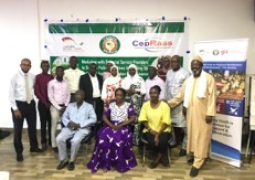The country also expects above average temperature for most parts of the country during this year’s seasonal rainfall.
The department predicted that annual rainfall amount will very likely be normal to above normal in the country for the entire period of July, August and September, based on the evolution of the Sea Surface Temperatures over the North and South Tropical Atlantic Ocean and Central Equatorial Pacific Ocean.
It added that “Most places in the country are, however, predicted to experience above normal annual rainfall with the highest amount above 1000mm expected in the western sector of the country (WCR, NBR and GBA). Amount in the range of 800 - 950mm is very likely over the rest of the country”.
To reduce the risk of water-related diseases (Cholera, malaria, diarrhoea, etc.) in wet or flooded areas, the department strongly recommends awareness raising on climate-sensitive diseases, in collaboration with meteorological, hydrological and health services; vaccinate people and animals, encourage the use of mosquito nets, set up stocks of anti malarial; provide stocks of medicines in hard-to-reach areas following the floods; monitor water quality and set up stocks of treatment products; as well as strengthen the capacities of national health systems and disaster risk reduction platforms.
Meanwhile, in anticipation of the rainy season, the Department of Water Resources (DWR) has forecast the 2020 seasonal rainfall in most parts of the country to be “above normal rainy season”.
The 2020 Seasonal Rainfall Prediction (SRP) is in fulfillment of the department’s responsibility to provide timely and reliable weather/climate information and services to all weather sensitive sectors of the economy.
Such information is use for strategic planning and for climate-smart decisions and practices which could bring about reduction of losses from adverse weather, minimize disasters and maximize output for key sectors such as Agriculture, Water Resources, Environment, Transportation, Budget, Planning, Health, Communication, Power, Construction, Tourism, among others.
Like previous years, the 2020 SRP is produced based on the strong tele-connection between the state of the central equatorial Pacific Ocean sea surface temperatures and rainfall systems/pattern in The Gambia, otherwise called the El-Nino Southern Oscillation (ENSO) tele-connection.
According to DWR the 2020 prediction is based on only a single phase of ENSO (Cold Phase or La-Nina) which has been predicted to dominate and persist through a long period of the season from May 2020 to July-August-September 2020 season with high probability (above 52 percent).




